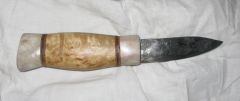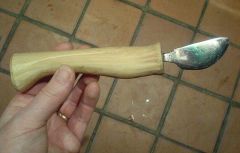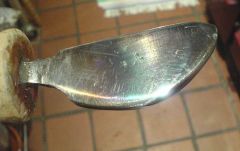
Declan Kenny
Members-
Posts
39 -
Joined
-
Last visited
Content Type
Profiles
Forums
Articles
Gallery
Downloads
Events
Everything posted by Declan Kenny
-
Torsion Bar for making tools
Declan Kenny replied to Declan Kenny's topic in Blacksmithing, General Discussion
That lathe looks nice and solid. Did you ever make bowls on it? -
Torsion Bar for making tools
Declan Kenny replied to Declan Kenny's topic in Blacksmithing, General Discussion
That's great stuff (particularly the bit where the forum swings into action when I'm hitting the hay!). I am not at the forge welding stage yet, but I hope to progress to that. Mind you, with the amount of good quality scrap available, there's no need. I am using a pole lathe for demos, but in the workshop, I don't have the room, so I use bungee cord and a thin leather strap. Great for turning bowls. Haven't tried forging on site yet, for the public - that's a private matter for now, 'til I get half decent at it. I'd love to see some pics of your lathe. Cheers again. Dec -
Torsion Bar for making tools
Declan Kenny replied to Declan Kenny's topic in Blacksmithing, General Discussion
Hi, I'm one of those 'traditional' turners! I try and do things from the early mediaeval period of European history, or Viking Age, as it's sometimes called in Ireland. To that end, I made my own lathe for bowl-turning, and try and forge my own tools. The traditional hook tools were all made from one piece of iron with long wooden handles. It's tempting to go the carbide route, but then I'm trying to cut timber, not corners... Thanks for the reply though; it would certainly save time. -
Torsion Bar for making tools
Declan Kenny replied to Declan Kenny's topic in Blacksmithing, General Discussion
Nope - no power hammer here I'm afraid, but on the plus side, hook tools don't require much work on the forge; it's getting an edge and keeping it that requires the time! Cheers, Dec -
Torsion Bar for making tools
Declan Kenny replied to Declan Kenny's topic in Blacksmithing, General Discussion
Thanks for the replies. The torsion bar I picked up today is solid, and looks to be good quality. I'll have a crack at a few tools over the next week or so and post some pics. -
Hi, I've no doubt this topic has come up before, but I am going to get my hands on some torsion bar to try and forge some wood turning hook tools. The steel will come out of a breakers yard from old cars; I'm hoping to get it at around 16 - 18mm in diameter. The main issue is, I guess, that I will have no idea what the composition of the steel is. Is it safe to assume it should have a reasonable carbon content of around 0.5% and more? And what typically would the other small percentages be made up of? Chrome, nickel? I've no idea, but I suspect they all vary hugely. Are there any issues in terms of forging heat, annealing and tempering? Or just treat it as ordinary carbon steel and see what happens? Thanks in advance.
-
-
Leaf spring steel for tools?
Declan Kenny replied to Declan Kenny's topic in Tools, general discussion
The first two hooks are ready for grinding an edge in the morning. -
Leaf spring steel for tools?
Declan Kenny replied to Declan Kenny's topic in Tools, general discussion
Thanks again for all the advice. I can get my hands on coil spring no problem. Made a couple of hooks today, one from an old chisel, and one from a large round file; I'll see how well they hold an edge tomorrow when I grind, temper and sharpen. Cheers, Declan -
Leaf spring steel for tools?
Declan Kenny replied to Declan Kenny's topic in Tools, general discussion
No, not off topic at all. There's no reason why small amounts of really good steel could not be welded onto mild bar for the shafts - after all, these hook tools are quite long, and it would eat up lots of good steel, most of which would never be used for cutting. Having said that, I would need to bow to greater knowledge for such welding skills, and fortunately, my mechanic friend next door is just the man! But for historical accuracy, I would be grinding this weld down to 'hide' it. And the changeable tips wouldn't be a runner at all. But then most of the timber to be turned on a pole lathe is relatively green, so carbide should not be necessary. -
Leaf spring steel for tools?
Declan Kenny replied to Declan Kenny's topic in Tools, general discussion
Sure. Will do. -
Leaf spring steel for tools?
Declan Kenny replied to Declan Kenny's topic in Tools, general discussion
I agree it's really an anvil, but 'moulding block' seems to fit in better with the Triad. It's definitely my favourite. The other one I like is: triad 238: Tr -
Leaf spring steel for tools?
Declan Kenny replied to Declan Kenny's topic in Tools, general discussion
Yes, thralls are hard to come by! But if you Google Robin Wood Battle of the Bowl Turners (or on YouTube) you can see that the pole lathe is really rather nifty. Thanks for all the feedback. I've just tested a few bits of steel in the workshop and I definitely have some prospects there for a hook tool or two. If I have any luck, I'll post some pics. It's a long term ambition of mine to forge a whole carpenter's set of tools, a la Mastermyr. With the recession here in Ireland, I might just have the time... -
Leaf spring steel for tools?
Declan Kenny replied to Declan Kenny's topic in Tools, general discussion
Thanks for those replies. I'll give it a go and see how I get on. I think the springs I have are not that old, and so probably even poorer quality steel than some of the stuff you guys in the States have. I have a few files as well, so might try both and see how they compare. -
Hi, I am hoping to make some hook tools for a pole-lathe for turning bowls this weekend. I picked up a few pieces of leaf spring from a scrap yard today. Do you think the steel generally in these car parts should be okay for making gouges and hook tools for turning, or is it really a hit-and-miss thing with scrap steel? I have no way of finding out the carbon content other than the usual temper and file method. Any thoughts? Cheers, Declan
-
-
-
Thanks for that. Sounds like the stuff to use!
-
Cheers Rich. I will give it a go in the morning.
-
My wife and I are living historians /reenactors and make all our gear, accrouterments,clothes,etc as historicaly accurate as possible. One of the main reasons I took up blacksmithing.
-
Sometimes it's better to remain silent and be thought a fool than to open one's mouth and remove all possible doubt... or put another way, maybe I should listen for now, and learn! But thanks for the invite. Now where's me Jameson...?
-
Thanks for that link - lots of good stuff there. I sense I will have quite a few 'oops' moments over the next wee while! I sense (being on GMT here in Ireland) that I will have hit the hay when you guys are chatting online. But no doubt there will be plenty to read up on in the forum. Thanks again.
-
Thanks for that. Glueing in the handle would have been the very last thing I would have done in any case, so there would have been no danger of heat damaging the epoxy, but it's a good point to bear in mind. I wonder what (if anything) our ancestors might have used? Perhaps a hide glue. I also understand making a very fresh green handle works too, in that the seasoning of the timber causes shrinkage which naturally grips the tang.
-
Hi, I have made a few small blades from parts of old files. I forged them both around the same time and achieved the shape I wanted. I then left them to anneal in ash before grinding and polishing. I have yet to temper them. I suspect I should have tempered them before I tried to get a good finish and an edge. Two questions, then: at what stage should you temper the blade? I also hope to fit simple wooden handles (most probably in yew). As these knives are to be approximately early mediaeval in style, and quite simple in design, I won't use rivets. However, to make sure the tang doesn't either split the wood or twist in the handle in use, I was thinking of using some form of epoxy glue. Second question: does anyone recommend anything in particular for this job? (I'll post the pics when I fit the handles). Many thanks, Declan
-


